Many images were posted on Sunday and Monday of tornado damage at Red Haw State Park, where the campground took a direct hit late Saturday afternoon, killing Jesse Theron Fisher, 40.
The photos and drone footage are disheartening --- shattered trees and scattered debris.
But Mr. Fisher's death is the tragedy here; everything else can and I'm sure will be repaired, including docks, a fallen shelter house and other infrastructure. Nature will take care of the rest, but patience will be required and damaged areas of the park that we're used to seeing as wooded and, in the spring, filled with redbud blossoms, will look substantially different this year.
But remember that most of the park remains intact and spring will come, as it always has.
Quite a bit of concern has been expressed about the Stone Shelter, so I asked my friend, Bonnie Friend, DNR ranger at Red Haw, about its status this morning. Here's her kind response: "Sure Frank! The stone shelter and youth shelter as well as that boat restroom were not touched by the tornado! They’re beautiful! Sadly though because of work being done in the campground and along that road where the tornado hit, the road will be closed to the campground and stone shelter probably until August!"
The Youth Shelter is the newest of the Red Haw shelters, located in the north part of the park along with the ranger residence, administrative buildings and beach.
Here's a map of Red Haw showing its various parts as well as its geographical relationship to Country Cabins and the Frontier Trading Post.
It took roughly 85 years for nature, assisted by human effort, to create the Red Haw we're familiar with --- driveways winding through wooded hills with picturesque views of the lake
When work began here in 1934, the park consisted of barren hills without native timber but with plenty of brush cover, most notably small American hawthorns known as red haws, hence the original name of the park, Red Haw Hill. Workers housed in forestry CCC Camp Chariton planted an estimated 100,000 trees on those hills during the later 1930s, many of which still stand, some of which were destroyed or badly damaged Saturday.
The aerial image at the top here is not especially sharp, but it shows how the park looked soon after the dam had been closed in 1935 and the lake had begun to fill. I've noted the areas were the campground was developed and the stone shelter built.
An amended version of what was known originally as the "fishermen's shelter" was among the buildings destroyed late Saturday as the tornado headed across the lake to strike Country Cabins and the Soda Pop Saloon-Frontier Trading Post. That shelter shows up in the image below, looking north (dam upper far right) about 1950.





No comments:
Post a Comment